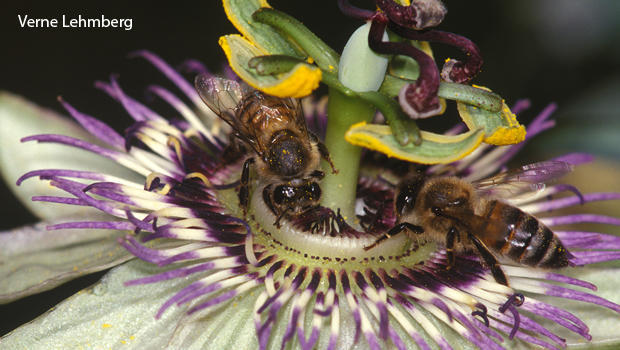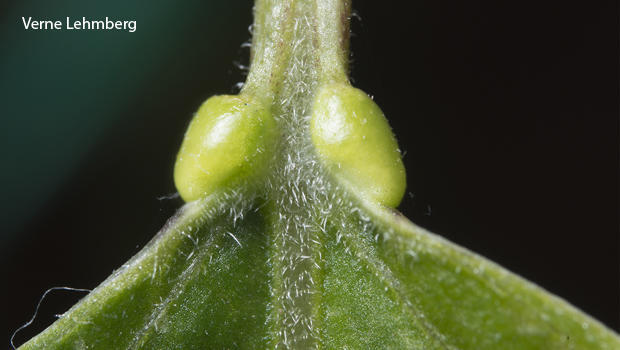Nature up close: A plant that tricks butterflies
By "Sunday Morning" contributing videographer Judy Lehmberg.
Butterflies aren't the most numerous insects, but because of their beauty they are the most noticeable. Last week's Moment of Nature highlighted the cabbage white butterfly in New Jersey, probably the most common butterfly in the U.S. Another common species is the Gulf fritillary, which can be found throughout the southern states as well as Mexico, Central America and even in parts of South America.
All butterflies have a multistage lifecycle. It starts when a female lays her eggs on a host plant, a plant her babies like to eat. When the eggs hatch, the caterpillars begin eating and go through a series of instar stages. Being arthropods that must shed their exoskeleton and replace it with a larger one in order to grow, each instar stage is completed when the caterpillar sheds its current exoskeleton and then puffs itself up with air so its newly-forming exoskeleton is larger than the one it replaces – it will thus have space to grow into.
Once the caterpillar gets large enough, or runs out of food, it produces a blob of silk by which it attaches its back end to a twig or other handy firm object. Then a most remarkable thing happens: metamorphosis. The word means literally a change in form, and butterflies are masters of the process.
After they form a chrysalis (a protective covering), all of their cells begin to move around and produce new structures, including wings, antenna, long legs, and a long proboscis. They completely change everything.
Once that process is complete, their chrysalis begins to crack open on the dorsal side, and they emerge as an adult butterfly. It takes them from a few minutes to over an hour to pump fluid into their wings to stiffen them for flying and to dry off. Once that is finished, they are off to find flowers (on which to feed), and a mate (with whom to start the process over).
Gulf Fritillary butterflies are selective about where they lay their eggs, and where they get the nectar they eat. They lay their eggs on passionflower vines. The ones in our yard in southeast Texas use Passiflora incarnata, a beautiful native vine. The eggs are tiny yellow dots on the passionflower leaves that turn a darker orange color as they age. In four to eight days, depending on the temperature, the eggs hatch, and the tiny caterpillars begin feeding on the passionflower leaves.
Passionflowers have developed some defenses against butterflies laying eggs on their leaves. Female fritillaries don't like to lay their eggs on passionflowers that already have eggs because their babies won't have as much to eat. The passionflowers actually make fake butterfly eggs on their leaves so a female fritillary is less likely to lay its eggs there. The fake eggs are also sugar nectaries that attract ants, which sometimes eat the butterflies' eggs.
The adult butterfly sucks sugary nectar from many different flowers, but primarily from tubular flowers that, due to their shape, don't allow bees in. The Turk's Cap Mallow's flowers have petals that usually keep away all nectar feeders except hummingbirds. The ruby-throated hummingbird and the Turk's Cap Mallow are partners that fit together like a hand in glove. Turk's Cap pollen has sharp spines on the grains, and as the hummingbird forces its long beak into the flower, the sharp spines on the pollen grains attach to the hummingbird's head and neck feathers, and are then transported to the next Turk's Cap flower.
The Gulf Frittillary butterfly, however, can steal from the Turk's cap without pollinating the flower (that is considered cheating in the biology world!), while also depriving hummingbirds of nectar.
This is just one example of the complex relationships that have evolved in birds, butterflies and plants.
To attract butterflies to your yard you need both nectar and host plants. The Lady Bird Johnson Wildflower Center has a list of hundreds of native plants to attract moths and butterflies. You can use their guide to select the plants best suited for your state, available light, and moisture requirements. It is best to select a variety of species (especially the nectar plants), so you will have blooming plants for as long as possible.
Judy Lehmberg is a former college biology teacher who now shoots nature videos.
See also:
- Judy Lehmberg (Official site)
- Judy Lehmberg's YouTube Channel
To watch extended "Sunday Morning" Nature videos click here!







